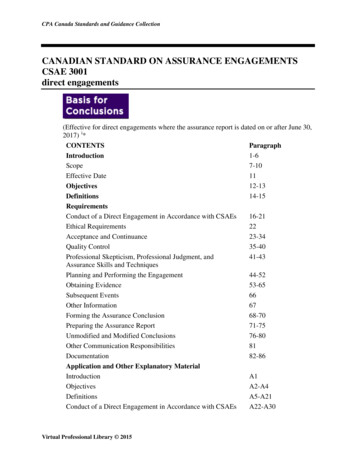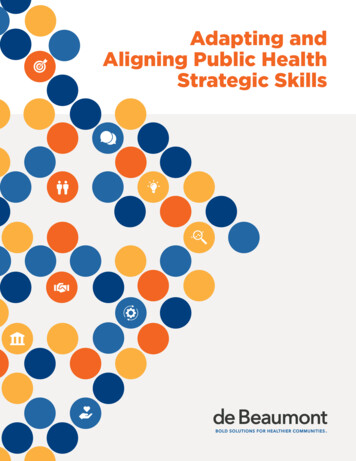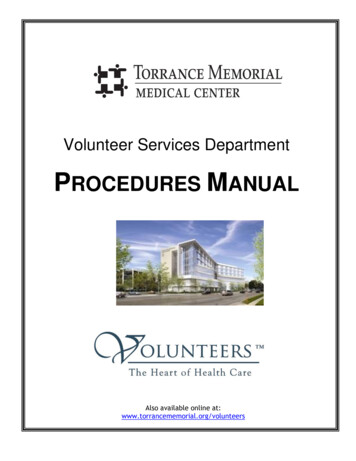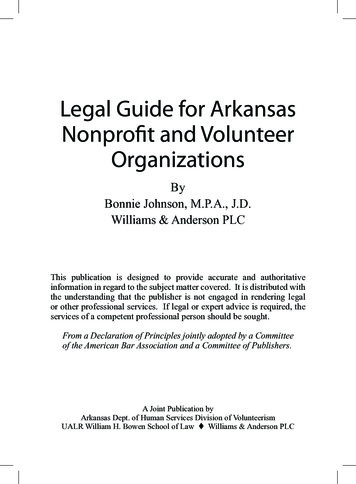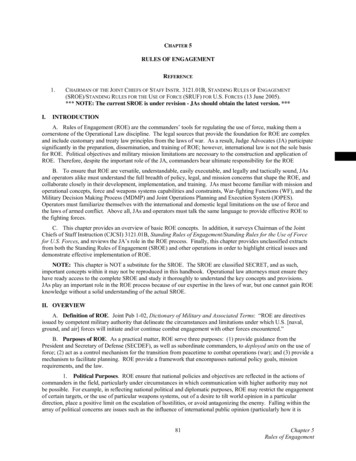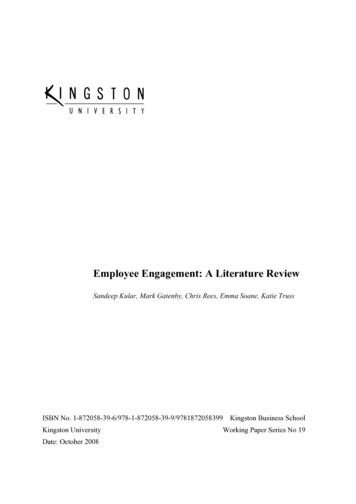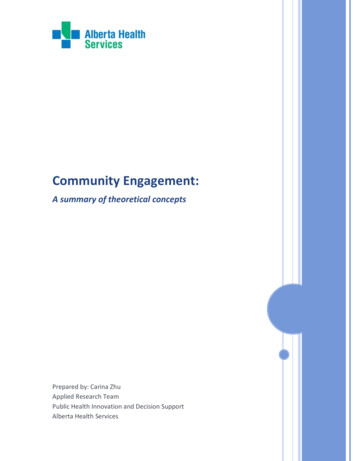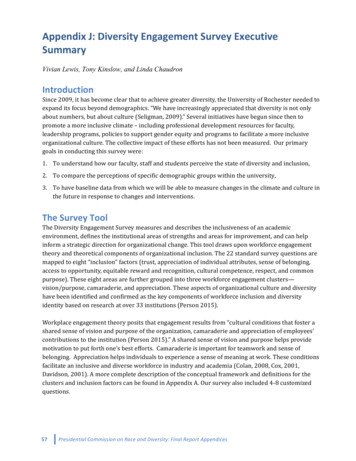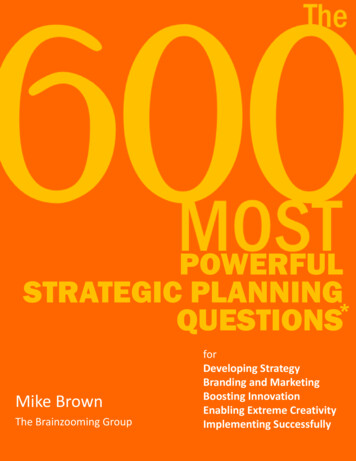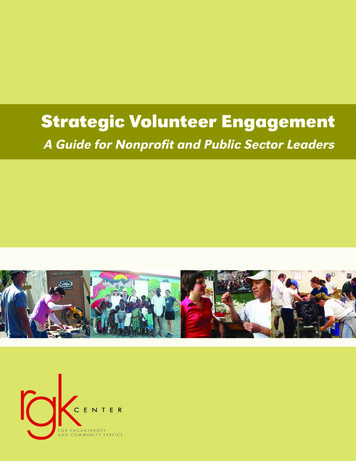
Transcription
Strategic Volunteer EngagementA Guide for Nonprofit and Public Sector Leaders
Strategic Volunteer EngagementA Guide for Nonprofit and Public Sector LeadersBySarah Jane Rehnborg, Ph.D.with assistance fromWanda Lee Bailey, MSWMeg Moore, MBAand Christine Sinatra, M.PAff.A publication of theRGK Center for Philanthropy & Community ServiceThe LBJ School of Public AffairsThe University of Texas at AustinDate: May, 2009The development of Strategic Volunteer Engagement: A Guide for Nonprofit and Public SectorLeaders was made possible by a grant received from The Volunteer Impact Fund, a collaborative funding initiative of the UPS Foundation managed by The National Human ServiceAssembly. Advisors to the grant received by Sarah Jane Rehnborg of the University of Texasat Austin were Betty Stallings, Building Better Skills; Susan J. Ellis, Energize, Inc.; JaneLeighty Justis, Leighty Foundation; Jeff Brudney, Cleveland State University; and JackieNorris (ret.), Metro Volunteers Denver.The printing of this edition of Strategic Volunteer Engagement is made possible by theOneStar Foundation, Austin, Texas.
An Executive Director’s GuideVolunteers: A Distinctive Feature of the NonprofitSector – A Critical Asset to the Public SectorPrefaceOne of the most distinctive features of the nonprofit sector is itsvoluntary nature. Nonprofits do not coerce people to work withinthe sector nor do they possess the right to mandate the use of theirservices (Frumkin, 2002). For nonprofit organizations, “free choiceis the coin of the realm. Donors give because they choose to do so.Volunteers work of their own volition” (p. 3).Clearly, volunteers—an unpaid workforce available to further thegoals and to help meet an array of needs in resource-constrainedorganizations—represent one of the critical competitive advantages of the nonprofit sector. An estimated 80 percent of third sector organizations report engaging volunteers in service capacities(Hager, 2004). Although comparable volunteer data pertaining tothe public sector is elusive, we do know that volunteers are heavilyengaged in public safety work, K-12 education, cultural arts, socialservices, and policy development. Furthermore, expanding Congressional appropriations make possible major national service initiatives including AmeriCorps and AmeriCorps VISTA, service-learningprograms at all levels of education, and senior service opportunitiesincluding RSVP, Foster Grandparents and Senior Companions (Rehnborg, 2005).Despite the idiosyncratic role of volunteer involvement within the nonprofit and public sectors,remarkably few organizations possess the knowledge to strategically maximize this advantage.Equally few decision-makers understand the basicconstructs of volunteer engagement. Many in topleadership positions do not know what they mightexpect from an engaged volunteer workforce, norare they aware of the critical importance of an infrastructure designed to facilitate and support community engagement.While leaders of nonprofit and public sector organizations have grown accustomed to seeing theirroles defined in terms of leveraging tight resources,maximizing community engagement, and advancing organizational growth and development, toofew have made the connection between those goalsand creating an effective system for volunteer en-2
to Maximizing Volunteer Engagementgagement. Furthermore, misconceptions about volunteer engagement abound. Executives in both sectors fear opening Pandora’sbox should they misstep with their community engagement strategies. Nonetheless, informed top-level support is critical to maximizing volunteer participation; managing diverse volunteer communityinterests and resources; facilitating productive relations among staff,volunteers, and clients; protecting against volunteer-related liabilities; and ensuring that voluntary labor connects with the organization’s strategic goals.We offer here a strategic framework and guidance for current andfuture nonprofit and public sector leaders open to exploring theramifications and implications of engaging volunteers in missioncritical work. The information in this report emerged from the findings of Volunteer Champions Initiative, a research project funded bythe Volunteer Impact Fund and conducted by The RGK Center forPhilanthropy and Community Service at the LBJ School of PublicAffairs at The University of Texas at Austin. This research engagedskeptics as well as ‘true believers’ in intensive dialogue about boththeir fears and their positive experiences with volunteers. We listened carefully to leaders living in Denver, Colorado and Austin,Texas. We heard their questions, we explored the shortcomings ofworking through volunteers and we garnered success stories. TheStrategic Volunteer Engagement: A Guide for Nonprofit and Public SectorLeaders emerged as a result of this work.Executive level support of volunteer involvement is a critical issuein volunteerism. This Guide is part of a larger effort addressing thiscritical need and builds upon and interacts with the work of somethe advisors to this project. Specifically, Susan J. Ellis, President ofEnergize, Inc. is the author of From The Top Down. A third, revisededition of this best-selling book on the topic of The Executive Role inVolunteer Program Success will be published later in 2009. In addition, a “how-to guide” is under development by Betty Stallings, offering checklists, templates, and other practical tools to implementthe principles Ellis’ work presents. Stallings builds upon her earlierempirical analysis of executive directors specifically known for being supportive of volunteers; that work was previously produced as12 Key Actions of Volunteer Program Champions: CEOs Who Lead theWay. The publications of Ellis, Stallings and Rehnborg are designedto be complementary, together seeking to build a body of knowledge and inform current and future organizational leadership abouteffective practices supporting volunteer engagement.3
An Executive Director’s GuideA Word About WordsThroughout this report we will be using several words interchangeably: Leaders, executives and executive directors apply to the leadership ofboth nonprofit and public sector organizations. Leaders may benonprofit or public sector executives, nonprofit board membersor public sector advisors, or elected officials and others in decision-making roles pertaining to community engagement. The term volunteers includes national service and service-learningparticipants, interns, ‘traditional’ volunteers, employee and service groups and those associated with service delivery for no orbelow market value remuneration. Although volunteers are involved in private/for-profit organizations as well as the public and nonprofit sectors, generally speaking, the term nonprofit will apply to all sectors of volunteer involvement. References to Strategic Volunteer Engagement: A Guide for Nonprofitand Public Sector Leaders within this report may utilize the full titleof the report or may be shortened to The Guide.This Guide may be used in conjunction with the case study “Go Volunteer Probono: Building the Case for Engaging Specifically SkilledVolunteers in Today’s Nonprofit Sector” s.php) for graduate and undergraduatecourse work.4
to Maximizing Volunteer EngagementVolunteer Engagement:A Two-Way, Multifaceted ExchangeTraditional approaches to volunteer engagement often follow amodel something similar to the process captured in Figure 1.Sometimes this process achieves its goals; more often, the minimaleffort put in by nonprofits results in minimal outcomes, meetingneither the needs of the organization nor those of the volunteersinvolved. In the end, volunteers are frequently blamed for the shortcomings, and, while the organization continues to publicly recitethe platitudes of community engagement, the truth is that volunteerengagement is neither supported nor encouraged.Five big challenges confront this model, each based on a particularfalse assumption.While it is true that volunteers operate without receiving market-valuecompensation for the work performed, any serious organizationalinitiative—of any type—requires a strategic vision and an outlay oftime, attention, and infrastructure. Someone needs to be assigned theimportant task of overseeing the venture, of facilitating community involvement, of preparing volunteers for the task at hand, of supportingtheir ongoing involvement, and of thanking them for the time given.The organization needs to know what it hopes to achieve and how thatend product will help meet the overall goals of the group. The organization’s staff and leadership need to be committed to working withvolunteers and, in many cases, offered staff development opportunities to learn how to work well with the community. In short, a credibleeffort needs a vision and plan, resources sufficient to the task at hand,and a dedicated, skilled, point person to assure that tasks run smoothlyand reach completion.When it becomes apparent that effective volunteer engagement requires an investment, especially a financial investment, many nonprofit leaders hit a brick wall. Won’t funders and board memberssee it as “cheating” to invest in free labor? On the surface, the twoconcepts appear antithetical. Complicating the matter is the issue ofreturn on investment, the holy grail of financial decision-making.Frequently, nonprofits are willing to wrestle with the complex andnuanced concerns of making their own services tangible, whetherprotecting elders from abuse, granting wishes to dying children, orpreserving green space in urban areas. But finding a way to concretize the processes involved in helping—and tying these processes tooutcome measures—stymies many financial gurus and organiza-Myth #1Volunteers are free.Myth #2You can’t “invest”in voluntary efforts.5
An Executive Director’s GuideFigure 1The Cycle of Poorly Managed Volunteer Engagement6. When the effort achieveslittle, volunteers receive theblame and are approached withskepticism, if at all, the nexttime their service is required.1. The nonprofitrecognizes it needsassistance to achieveits mission.2. The agency assesses its financialresources and findsthem deficient.5. A staff person may oversee the volunteer effort, butexpectations, accountability,& communication remainunclear.4. The organizationissues a call and findsvolunteer(s) who mayor may not be qualifiedfor the task.3. The leadership(ED/board) assumesvolunteers’ free laborrequires little financial/strategic investment.tional leaders alike. Nonetheless, volunteer engagement is a process, no different than fund development or marketing: it connectsnonprofits with mission-critical resources. Few question spendingmoney to raise money; spending money to raise people (a prerequisite to raising money) is just as necessary.6
to Maximizing Volunteer EngagementThe model in Figure 1 suggests that the needs and motives of justone party in the volunteer-nonprofit relationship are important:the needs of the organization to see a task completed. As such, itcontrasts with the nonprofit or public sectors’ approach to nearlyany other commonly cultivated relationship, where two-wayexchanges predominate. For example, relations between a nonprofit organization and its staff are characterized not only by thework staff contributes to the organization but also by what theorganization provides its employees (salaries, benefits, professional development, and the like). Similarly, relations with donors are characterized not only by the input of the donors’ fundsbut also the organization’s ongoing efforts to build a bridgewith those donors. Clients, members, or constituents play a rolein helping a nonprofit fulfill its mission; they receive in returnproducts, services, and, often, opportunities for input into theorganization’s overall direction. Thus, only volunteers receive theexceptional—and generally unproductive—treatment of regarding their need in return for entering into a relationship with anonprofit as vaguely equating to the nonprofit’s own needs (i.e.,the volunteer needs no more than whatever satisfaction can beattained in having helped you complete a task or meet a goal).What makes the matter worse yet is that many volunteers neverlearn how their efforts actually support the nonprofit.Myth #3Volunteers wantonly what you want.Myth #4If the volunteers’ needs are considered within the equation atall, it is often from a negative or punitive perspective. Executivesreport that they are not in the business of meeting the needs ofvolunteers, that such a perspective can take away from attentionto mission, and that any implication that organizations shouldexpend effort considering the needs of volunteers only makesthis community resource less attractive in their eyes. Likewise,EDs report that they fear potential negative exchanges with avolunteer. What if the volunteer doesn’t work out for the agencyand has to be removed from his or her appointed role? Erroneously assuming that volunteers cannot be “fired,” nonprofit leaders dread getting stuck with a poor worker or, worse yet, experiencing negative consequences in the community. Such nightmarescenarios, regardless of their basis in fact, almost completelyveil the potential value that may be reaped from a well-engagedvolunteer base. Furthermore, such concerns overshadow the factthat productive and lasting relationships of any type are builtwhen organizations seek to understand and meet the needs ofthe partner, whether that partner is a donor, staff person, boardmember, or community volunteer.Meeting volunteers halfwayis a recipe for trouble.7
An Executive Director’s GuideMyth #5Volunteer “work”is best defined as thatwhich staff wants no part of.The final challenge with poorly managed volunteer engagement is itsoversimplification and tendency to silo away the possibilities inherent in volunteers’ efforts. In many instances, the imagined task to befulfilled has certain predefined characteristics that make agency leadersview it as work for volunteers—separate and, at times, lesser in valuethan other work of the organization. Sectioning off volunteers’ workfrom other functions of the organization may make for a streamlinedappearance in an organizational chart; however, it limits the scopeof an agency’s ability to leverage significant community resources—particularly when volunteer work becomes defined only as that whichis rote or unappealing (or otherwise overlaps with tasks that staff feeloverqualified for or prefer to avoid).By contrast, diverse, multilayered volunteer engagement experiences—built on the abilities and interests of the volunteer, as they align with theoverriding mission and goals of the organization—can address a host ofdiscrete purposes within an organization. First, organizational leadersmust learn to move beyond the stereotypes sometimes associated withvolunteers, those images of unthinking, low-level robots available for anymindless task, and realize that the word “volunteer” connotes a pay scale,not a function. Volunteers manage archeological digs, train seeing-eyedogs, serve as board members, manage city government, fight fires, andrun nonprofit organizations. What matters is the vision associated with theidea of volunteers and volunteering. Imagining low-level functionarieswith limited abilities will lead you to design jobs only for such a person.On the other hand, envisioning a highly qualified artist painting a muralin your hallway, or a CPA overseeing a restructuring of your accountingsystems, or a ropes instructor guiding your staff through a team buildingexercise will likely lead you to create and fill a position for just such a person with time and interest in service.In fact, today’s volunteers offer nearly unlimited potential to thenonprofit that is willing to move beyond these old myths. Toachieve this perspective, the Volunteer Champions Initiative formulated The Volunteer Involvement Framework . The Frameworktakes a broader view of volunteer engagement, considering both theneeds of the organization and trends in present-day volunteerism.This perspective correlates the work that needs to be done in an organization with the management strategies needed to support thatwork and combines it with the volunteers’ particular interests, motives, levels of commitment, and time availability. The Frameworkprovides a starting point for examining the organization’s currentlevels of involvement and creates a blueprint for planning for moreextensive community input.8
to Maximizing Volunteer EngagementThe Volunteer Involvement Framework The Volunteer Involvement Framework captures contemporarythemes in volunteer engagement and organizes this information forprioritizing and decision-making purposes. The tool—developedwith assistance from nonprofit leaders—enables executive-level decision-makers to identify their current volunteer engagement practices, examine additional service possibilities, and identify appropriate staffing and other management considerations. The Frameworkguides leaders as they analyze, plan, and make decisions, providing a useful visual summary that helps organize strategic thinkingabout volunteer engagement. In short, the Framework examines thefull range of options available for creating a volunteer engagementsystem tailored to meet the unique needs of the organization.The Framework is a simple two-by-two matrix. The horizontal “connection” columns distinguish between the two predominate orientations of volunteers currently in the marketplace. The first of these is the “affiliationThe Volunteer Involvement Frameworkoriented” volunteer. This person graviconnection to servicetates to a service-opportunity in order toAffiliation Focusassociate him or her self—with either thecause or with the mission or purpose of theorganization, or with the group or networkof friends engaged in the service. For thisEpisodicvolunteer, the orientation to the type ofservice, or the friends or colleagues withwhom they will serve, is of greater significance then the type of work being done.By contrast, the “skill-oriented” volunteer,represented in the column to the right, isa person who is more likely to express aninterest in or a connection with the type ofLong-termwork performed as a volunteer. This person views the skills that he or she brings toservice as paramount and wants to offer thisspecialized expertise to the organization.TMtime for serviceSkill FocusThe vertical “time” dimension of the matrixcaptures the person’s availability for service. The top row represents a shortterm service commitment. Short-term may indicate a short stint of service(volunteering that occurs over a determined number of hours in one day orweekend), or it may suggest a specific, time-limited focus, where the volunteer signs on for a specific project that is limited in nature (although the project may occur on an annual or some other recurring basis). This volunteer isfrequently called an “episodic” volunteer. The bottom row of the framework9
An Executive Director’s GuideThe Volunteer Involvement FrameworkTMOverview of Types of Volunteersconnection to serviceAffiliation FocusExamples of Service: Corporate days of service with work teams Weekend house-build by a local service club Park clean-up event or trail maintenance Walkers, bikers, runners for annual fundraiser.time for serviceShorttermEpisodicExamples of Service: Youth mentor Troop leader Sunday School teacher Environmental sustainability advocate Hospice visitor Park host or docent Thrift store manager Auxiliary member or trusteeLongtermOngoing10Traits of Volunteers: Strong sense of connection to the cause, work group, club,or organization. Generally expects a well-organized event (materials andinstructions immediately available to perform task, etc.). May be using the service opportunity to investigate aparticular organization. May be part of a service group or meeting service requirements of a school, workplace, or club. May have unrealistic/ naive expectations about the abilityto impact clients or long-term work of the organization. May prefer to identify with their service club or companyrather than the organization being served.Traits of Volunteers: Committed to the group or organization and the cause ormission it represents. Often willing to perform any type of work for the cause,from stuffing envelopes to highly sophisticated servicedelivery. May need specialized training to prepare for the serviceopportunity (e.g., literacy tutoring, etc.) May feel a special affinity to the organization because ofpast benefit, family connection, or other personalallegiance. May be any age, although age may segment type of causemost likely championed. May be ideologically motivated (religious, political, environmental, etc.) to champion a cause or issue. Appreciates regular recognition, both formal and informal. Often uses personal pronouns to talk about organization(me, we, us, our) In addition to strong motivations for service, may well be akey donorSkill FocusExamples of Service: A one-time audit of an organization’s finances by a professional accountant A sports club teaching a youth group a particular skill andhosting youth for an event A student completing a degree requirement. A chef preparing a meal for a fundraiserTraits of Volunteer: Seeks a service opportunity tailored specifically to engagethe volunteer’s unique skill, talent, or resources. May be any age, although slightly more likely to be adultswith higher levels of skills/education. Likely expects mutuality, i.e., a peer-to-peer relationshipwithin the organization (accountant to treasurer; event hostto ED; etc.) May seek to negotiate timing of service. Appreciates recognition that is tailored to the uniquedemands of the position. May prefer to think of self not as a “volunteer” but anintern, pro bono consultant, etc., or other functional title.Examples of Service: Pro bono legal counsel No-cost medical service by a physician, EMT, nurse,counselor, etc. Volunteer fire fighter Loaned executive Board memberTraits of Volunteers: Similar to the quadrant to the left in commitment. Generally prefers to contribute through specialized skillsand training. May elect to contribute talents through specialized serviceor may contribute time through policy and leadership rolessuch as board governance, visioning, etc. Often expects volunteer management that reflects thecultural norms of the given specialty or skill. Often combines talent with dedication to the cause,although the talent brought to the cause may supersede anallegiance to the mission. May have historical ties to the organization or cause and/or may have a family member (or self) who has benefitedfrom the services of organization. Expects staff support, assistance with resources necessaryto the job, and recognition appropriate to work performed.
to Maximizing Volunteer Engagementrepresents the person who agrees to serve on a regular, ongoing basis, potentially making a long-term service commitment.In the sample Framework on the next page, each quadrant containsexamples of voluntary service that typify that area of volunteer experience, followed by a synopsis of the more common traits and motivations for service. Despite the linear boundaries of the graphic, it’sworth noting that the Framework’s four quadrants are not mutuallyexclusive and that some of the distinctions between them are fluid,flexible, and permeable. A volunteer may elect to serve in all fourways over a lifetime. Likewise, an agency or organization will wantto examine opportunities for service within the organization thatfall within each quadrant, thereby providing a maximum level offlexibility when recruiting volunteers.In the remainder of this Guide, the Framework serves as a basis forconceptualizing a sustainable volunteer engagement program infour stages: Understanding volunteer motivations and trends (looking at the research on who volunteers are and what drives them) Creating a vision for volunteer engagement (thinking broadly aboutthe four quadrants and how to plan for them) Maximizing your investment in volunteers (management/personnelstrategies and a process for moving from vision to reality) Minimizing challenges and embracing opportunities (advice andresources that address leaders’ top concerns about volunteer engagement).Throughout the Guide and in the notes directly following it, youwill find resources to assist with further development of your community engagement initiative, including online tools and assessments. Additionally, Appendix A, which contains a worksheet foryou to make notes on your own organization’s use of and/or plansfor volunteers, allows for customization of The Volunteer Involvement Framework to meet your specific organization’s needs.11
An Executive Director’s GuideUnderstanding Volunteer Motivations and TrendsFigure 2Volunteering Facts Number of Americans who volunteer regularly:61 million Percentage of Americans who volunteer: 27% Total hours volunteered in the U.S. in 2006:12.9 billion Average volunteer’s hours of service in 2006:207 Average number of people volunteering on anygiven day: 15 millionSource: The Nonprofit Almanac 2008Volunteerism is multifaceted. Not only do people serve for a multitude of reasons, today’s volunteers serve in a variety of ways andwith various expectations for the return on their investment of energy and time. Additionally, not all people who serve without expectation of remuneration gravitate to the term “volunteer.” Studentsmay talk about internships or community service requirements. Teachers may seek service-learning opportunities in area organizations.Men tend to describe their service by the functions they perform(coach, trustee), while women have historically been more connected to the term volunteer. Theological interpretations of service vary.Some religiously motivated volunteers feel called to serve, while others say they’re compelled to live out their faith and still others seek topromote social justice through service. Professional associations maytalk about public interest work or pro bono opportunities. The very actof expanding the vocabulary associated with volunteer work opensup new ideas for envisioning service.Research on volunteerism provides interesting insights (see Figure2). Data from the Bureau of Labor Statistics, U.S. Census Bureau,and the Corporation for National and Community Service (CNCS)indicate volunteering today is at a 30-year high (CNCS, 2006).Older teenagers (16- to 19-year-olds, motivated by service-learningopportunities and similar trends), retirees (over 65), and mid-lifeadults (45 and older) are fueling this growth. Together with othervolunteers, they constitute a workforce numbering nearly 61 million, who give, on average, nearly four hours per week in charitableservice (Wing, Pollak, & Blackwood, 2008).Some researchers find even higher levels of engagement. For example, according to Independent Sector, when all volunteer involvement is accounted for—not only in charitable organizations butalso in religious groups, schools, communities, and informal neighborhood groups—the total unpaid labor contribution climbs evenhigher (Independent Sector, 2001). Estimates of the value of volunteer labor suggest the United States benefits from the equivalentof 239 billion of unpaid staff time or the equivalent of a full-timeworkforce of 7.2 million employees (Wing, Pollak, & Blackwood,2008). (For specific information about volunteering in your community, Volunteering in America offers excellent state- and city-leveldata at its interactive website: www.VolunteeringInAmerica.gov).Although motives for volunteering are as varied as the volunteers12
to Maximizing Volunteer Engagementthemselves, numerous studies (Bureau of Labor Statistics, 2007;Independent Sector, 2001;Musick,Rehnborg & Worthen, n.d.) havefound a common denominator: “being asked” is one of the keydrivers for volunteerism, with adults and young people alike citingit as among the top reasons they elected to volunteer or learned ofthe opportunity in the first place. Another primary driver for volunteers is affiliation with a cause or belief system—such as the desireto make a difference, to support a particular organization’s work,a religious sense of obligation, or simply “wanting to give back.”Others are motivated by external affiliation-relation incentives, suchas a desire to meet others, to be part of a team, to fulfill a youthservice requirement, or to meet the membership requirements of aservice club. Finally, evidence suggests a growing number of volunteers are driven by an interest in learning a new skill, the desire tomaintain skills while temporarily stepping out of the job market,the desire to explore a career opportunity or using skills they’vedeveloped over a lifetime (Musick & Wilson, 2008).Each of these distinct motives reflects trends in society and in volunteerism at large. Volunteers continue to be more well-educated,more likely to have families, and more socially connected than thepopulation as a whole. They also have distinct interests and needs.For example: Episodic volunteer opportunities: Those with limited time but aninterest in doing service on a temporary basis are being drawn toevents such as day-long house-builds with Habitat for Humanity, community park trail maintenance days, or special vacationsfeaturing “volun-tourism” away from home. Service linked to the private sector: Corporations and businessgroups, working to bolster their community involvement, do soby participating in programs to “adopt” a school or stretch ofhighway, complete a “day of service,” create technological braintrusts for nonprofits in need, or encourage employees to join selfguided hands-on service opportunities, often facilitated by a localvolunteer ce
Strategic Volunteer Engagement: A Guide for Nonprofit and Public Sector Leaders was made possible by a grant received from The Volunteer Impact Fund, a collab- orative funding initiative of
